Earlier this year the Group joined with the Professional Horticulture Group South West for a visit to Branstons, a major potato marketing organisation supplying UK supermarkets. A full report appears below.
In June members of the Group were treated to an informative mid-summer's day tour of the Harcourt Arboretum, part of the Oxford Botanic Garden which is also reported below.
On 3 July the Society will hold its Annual General Meeting and all members are encouraged to attend. The day will include the award of the Lampitt Medal, a presentation by the 2013 Seligman Fellow and the Annual Summer Lecture by the Society's Honorary President Mr Paul Booth.
Later in the month we will again join with the Professional Horticulture Group South West for a visit to Avon Bulbs and the National Trust Gardens at Tintinhull. Details will be posted on the website as soon as possible but for now please email.
Editor
Branstons Potatoes

The packing station was built on a piece of land owned by one member of the cooperative luckily now close to the upgraded A303. However access to the site and the A303 remains via a single track road - less than ideal for the large lorries bringing potatoes in from the 48 growers in the group and delivering to their customers.
Ian Waite, general manager of site (pictured right), explained the history of the company which now includes a Scottish unit at Abernethy in Perthshire. He then took us on an escorted tour in which we were accompanied by Operations Manager, Nick Brake, and Agronomist, Pascal Myles. We started where the potatoes do, at the weighbridge.
As each lorry arrives from the grower, with some of the 82,000 tonnes of potatoes that pass through the packing station, the contents are weighed. 10kg samples are washed and then assessed for quality, looking for skin defects, blemishes and disease. They then either go to cold store or are immediately graded. Potatoes due for eating are stored at 3°C while those for processing at 8°C.
The majority of the potatoes passing through the site are destined for Tesco which orders early each morning. These must be ready for dispatch by 3pm each day.
Potatoes are first graded for size by passing them across vibrating belts with holes of the appropriate diameter. The vibration is essential since, as everyone is aware, few potatoes are conveniently round and they need to be shaken to ensure they are presented to the grading holes in a variety of attitudes. The graded potatoes are then washed, polished to remove any residual soil, before being colour graded.
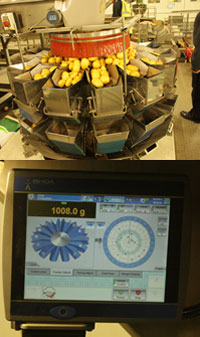
The packing machine itself is an ingenious gravity-fed system (pictured right). Cleaned and graded potatoes fall into one of 16 weighing cups. A computer then works out which combination of 2, 3 or 4 cups contains the nearest approximation to 2kg before opening the respective traps to allow those to fall into the bags below. A final check of the completed bag weights is made before they are boxed for delivery to the customer.
The company would normally aim to fill the majority of their orders from home-grown potatoes. However, last summer's wet weather created major shortages, with growers finding it difficult to lift the crop, and large losses when they did. As a consequence they were forced to import potatoes from France and further east.
All UK growers conform to Tesco's 'Nurture' standard of husbandry. However, when the company has to import to fill shortages, it relies on similar EU standards which, although slightly lower, are still high enough to be acceptable.
In addition to the 2.5 million packs supplied to Tesco each week, larger bags are also sent to other customers.
Washing potatoes inevitably results in large volumes of muddy water. This is all passed through a recycling plant where a combination of flocculation and filtration removes the soil and enables 80% of the water used to be recycled.
Peter Grimbly
Harcourt Arboretum
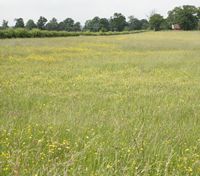
Our guide for the day, Senior Curator Alison Foster, explained that the artist, William Sawrey Gilpin (more), was involved in the original plantings, although there is some doubt as to the extent of his involvement. The Botanic Garden acquired the arboretum in 1963 and, over the last 50 years, purchased additional land and now covers 130 acres. Much of this land has not been used to extend the tree planting, but to create permanent wildflower meadows.
Our tour started in the rather prosaically entitled 'Pylon Meadow' (pictured right), named after the high voltage electricity pylon that stands in the middle. This is the oldest established of the meadows and has a wide range of species with the meadow buttercup, Ranunculus acris, very much in evidence at the time. Scattered plants of the hemiparasite yellow rattle, Rhinanthus minor, were also visible and, in one area where it was particularly dense, the dwarfing effect of its parasitism on the grasses was very apparent.
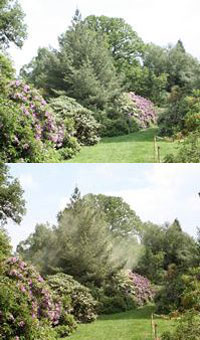
Part of the mature plantings originally acquired from the Harcourt estate was native woodland. This had been planted as a series of largely single species stands to create separate oak, lime and ash woodlands. Though 30 acres of the newly acquired land has been used to extend these woodlands, sadly an area of newly planted ash is highly vulnerable to the ash dieback fungus, Chalara fraxinea, that is sweeping across the country. Despite the young age of these plantings Alison was keen to show us two species of orchid that had become established - the spotted orchid, Dactyllorhiza fuchsia and a fine specimen of possibly Dactylorhiza majalis agg.
Our tour ended in the mature arboretum where Rhododendron and Cornus were
providing splashes of colour amongst the magnificent mature pines, cedars,
firs and redwoods. One pine tree in particular was taking advantage of the
gusty wind to shed large clouds of pollen (pictured right).
Peter Grimbly
Plant of the Month
Galium tricornutum, corn cleavers, Rubiaceae
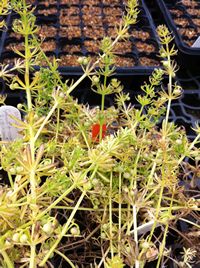
Corn cleavers, as its name might suggest, is an arable weed, a more diminutive sister species to the more familiar, widespread and much larger plant, cleavers (Galium aparine, goose-grass, pictured right).
Over recent decades, due to the changes in farming practice, arable weeds such as corn cleavers have come under significant threat of extinction. Corn cleavers, in particular, has been cited in the recent State of Nature report (a landmark report published by a coalition of 25 organisations, about the UK's wildlife) as an example of one of the most dramatic plant declines. Previously widespread, it is now reported to be found only at a single site in southern England.
However, the Rare Plants Group of the Ashmolean Natural History Society in collaboration with the University of Oxford Botanic Garden, are working to reintroduce this arable weed into a traditionally-farmed field close to Oxford, where it was previously recorded. We hope that the future is looking a little brighter for this species.
Alison Foster
Oxford Botanic
Garden
Medicinal Plant of the Month
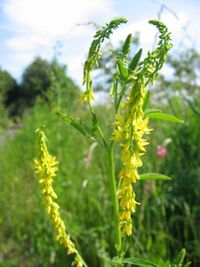
What might yellow sweet clover (pictured right) and another species of Galium (Galium odoratum) have in common? The answer will be revealed in due course.
But first, we must go back almost 100 years to the 1920s and move across the Atlantic ocean to North America. Much like in recent years in the UK, there was a series of very wet summers in the 1920s in America and all the hay and forage crop being harvested was rotting and going mouldy. The farmers were desperate, and were still having to feed this spoiled crop to their cattle. However, the cattle began suffering from a bleeding disease and were haemorrhaging to death.
One day a desperate farmer took a bag of his mouldy hay and a container of blood from one of his dead cows in to a local research laboratory and asked the chemists there to investigate whether there was a connection between the two. He was convinced (and rightly so as it turned out) that something in the hay was causing the death of his cattle.

However, this doesn't make either of these plants 'medicinal'. After establishing that dicoumarol was an effective anti-coagulant, the scientists then went on to synthesise analogous compounds, with similar structures to dicoumarol, in an attempt to understand which part of the structure caused the anti-coagulant effect, as well as trying to make more effective compounds.
Due to the perseverance of one particular student, a single analogue was then developed into the drug that today in the UK we know as warfarin. The research was funded by the Wisconsin Alumni Research Foundation (WARF). This drug, which is given to patients to control the clotting time of their blood, has saved countless lives after operations and also lives of people suffering from deep vein thrombosis. People often liken developing drugs to finding a needle in a haystack - and in this case it absolutely was!
Alison Foster
Oxford Botanic
Garden
Horticulture Industry News
For the very latest horticultural news follow us on Facebook,
Twitter, or LinkedIn
Plants can do maths
Plants have a built-in capacity to do maths, which helps them regulate food
reserves at night, research suggests. Scientists at the John Innes Institute
used mathematical modelling to investigate how a division calculation can
be carried out inside a plant to enable the plant to eke out its starch reserves
through the night.
During the night, mechanisms inside the leaf measure the size of the starch store. Information about time comes from an internal clock, similar to the human body clock. The researchers proposed that the process is mediated by the concentrations of two kinds of molecules called 'S' for starch and 'T' for time. If the S molecules stimulate starch breakdown, while the T molecules prevent this from happening, then the rate of starch consumption is set by the ratio of S molecules to T molecules. In other words, S divided by T. The researchers think similar mechanisms may operate in animals such as birds to control fat reserves during migration over long distances, or when they are deprived of food when incubating eggs. More
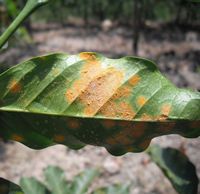
Coffee rust, Hemileia vastatrix (pictured right),
has reached epidemic proportions in Central America, threatening the livelihoods
of hundreds of thousands of farmers and the morning pick-me-up of millions of
coffee drinkers. Possibly exacerbated by growing practices and climate change,
the disease leaves coffee plants spindly and barren.
The effects haven't been felt yet among coffee drinkers in developed countries, but history gives a sense of the problem's potential magnitude. England only became a quintessentially tea-drinking nation in the 19th century, after rust outbreaks destroyed coffee plantations in Sri Lanka, and shifted production to Dutch Indonesia.
Coffee rust first occurred in Central America in the mid-1970s, but outbreaks didn't reach industry-threatening levels. Now they have. After the latest flowering season, rust afflicts more than 50% of growing areas, in a belt stretching from Guatemala through Honduras, El Salvador, Nicaragua, Costa Rica and Panama. More
Architecture and evolution of a minute plant genome
The evolution of plant genome size is principally unidirectional, and increasing
owing to the varied action of whole-genome duplications (WGDs) and mobile
element proliferation. However, extreme genome size reductions do occur.
One such is the 82-megabase genome of the carnivorous bladderwort plant Utricularia gibba. Despite its tiny size, the U. gibba genome accommodates a typical number of genes for a plant, with the main difference from other plant genomes arising from a drastic reduction in non-genic DNA.
Unexpectedly scientists have identified at least three rounds of WGD in U. gibba since its common ancestry with the tomato (Solanum) and grape (Vitis). The compressed architecture of the U. gibba genome indicates that a small fraction of intergenic DNA, with few or no active retrotransposons, is sufficient to regulate and integrate all the processes required for the development and reproduction of a complex organism. More
Give picked veg some light to make it better for you
Cabbages
produce repellent chemicals called glucosinolates to protect themselves against pests such as caterpillars and larvae. These have been found to
inhibit some cancers in rats and mice, and there has been some suggestion
that they reduce cancer risk in humans. Levels of glucosinolates in thale
cress (Arabidopsis thaliana), a relative of the cabbage, peak during the day,
when pests are most active, before dropping off at night.
To see if this was also the case in cabbages - even when detached from the plant - researchers measured how well cabbage leaves protect themselves against cabbage looper caterpillars. They found that if the cabbages were kept under artificial light during the day and in the dark at night, their leaves suffered 20 times less damage from the caterpillars than if the natural cycle was disrupted, for example, by being exposed to constant light. More
Plants seen doing quantum physics
Plants gather packets of light called photons, shuttling them deep into their
cells where their energy is converted with extraordinary efficiency. New work
adds weight to the idea that an effect called a 'coherence' helps
determine the most efficient path for the photons. This painstaking new study
done by aiming lasers at single molecules of the light-harvesting machinery
shows how light is funnelled to the reaction centres within plants, where light
energy is converted into chemical energy.
What surprised the researchers is not only that these coherences do indeed exist in plant tissues, but that they also seem to change character, always permitting photons to take the most efficient path into the reaction centres. Until recently, quantum mechanics would not have been expected in biological settings. The fact that plants and animals are extremely warm and soft would suggest that delicate quantum states should disappear in living things, leaving behaviour explicable by the more familiar 'classical physics' that is taught in school. More and More
Pistil leads pollen in life-and-death dance
It is already known that the gene expression in pollen tubes that have grown
through a pistil is different to pollen tubes grown in the lab. A research
group therefore examined which regulators of gene expression were at work
in pistil-grown pollen tubes, but not in the lab-grown ones. First they found
one called MYB120, and through genomic analysis, found two close associates:
MYB101 and MYB97. They found that these transcription factors accumulated
in the nuclei of the pollen tubes as they grew in the pistil.
Using Arabadopsis plants in which these transcription factors were disabled, they found that the pollen tubes would grow normally down the pistil. However, on reaching the ovule they failed to stop growing, and did not burst to release the pollen nuclei and effect fertilisation. Further investigation of the genes controlled by these transcription factors found that they encode a variety of tasks, but one in particular is responsible for the secretion of a protein called a thionin. Thionin has been described as being able to burst open cells. In other words, expressing that gene could be pushing the pollen tube's self-destruct mechanism to effect fertilisation. A well-controlled cell death situation. More
Your vegetables could be jet-lagged
Plants that are alive adjust to the conditions surrounding them and some plants
have circadian rhythms, adjusting their production of certain chemicals based
on their exposure to light and dark cycles. Understanding and exploiting these
rhythms could help us maximize the nutritional value of the vegetables we
eat. Using looper caterpillars and shop-purchased cabbages, a team exposed
half to a normal light and dark cycle, the same schedule as the caterpillars,
while the other half were exposed to the opposite light cycle.
Caterpillars tend to feed in the late afternoon, so the light signals the plants to increase production of glucosinolates, a chemical that the insects don't like. The study found that cabbages that adjusted to the normal light cycle had far less insect damage than the 'jet-lagged' cabbages. They also tested spinach, lettuce, zucchini, blueberries, carrots, and sweet potatoes. Just like with the cabbage, the caterpillars ate far less of the vegetables trained on the normal light schedule. Even the fruits and roots increased production of some kind of anti-insect compound in response to light stimulus. More
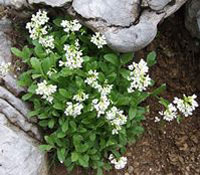
Perennial plants flower only when they have reached a certain age and been subjected
to the cold. These two circumstances prevent the plant from starting to flower
during winter. George Coupland and his fellow scientists from the Max Planck
Institute for Plant Breeding Research in Cologne have now discovered that the
Alpine rock cress (picture right) determines its age based on the quantity of a short ribonucleic
acid.
Perennial plants carefully balance periods of growth and flowering to ensure that they can live for many years. They do not flower when they are still too young and small or produce flowers on all their side shoots. Also, they do not flower out of season and they continue to grow after flowering. In temperate regions they do not produce flowers during winter, but only after exposure to a long cold period. This dependency on a cold stimulus is called vernalisation.
Scientists from the Max Planck Institute for Plant Breeding Research have now identified the molecular signals used by the perennial Alpine rock cress (Arabis alpina) to register its age and to realise that it has been exposed to vernalisation. The Alpine rock cress measures its age based on the concentration of a short ribonucleic acid known as miR156.
A purely regulatory nucleic acid, miR156 works like an hourglass. Just as the sand trickles through an hourglass and indicates the amount of time elapsed, so the concentration of ribonucleic acid in the Alpine rock cress decreases from week to week enabling the plant to measure its age. When the ribonucleic acid reaches its lowest level, the plant is old enough for flowers to form when it is also exposed to vernalisation. More
The contribution of particulate matter to forest decline
Air pollution is related to forest decline and also appears to attack the
protecting wax on tree leaves and needles. Scientists have now discovered
a responsible mechanism: particulate matter salt compounds that become deliquescent
because of humidity and form a wick-like structure that removes water from
leaves and promotes dehydration. The scientists sprayed salt solutions on
Scots pine needles and recorded their weight loss after abscission. The needles
treated with salt solutions dried out significantly faster than the untreated
control needles.
Using an electron microscope, the scientists observed the salts becoming deliquescent and moving into the stomata of the needles. The deliquescent salts form very thin liquid connections between the surface and interior of the needle, and water is removed from the needles by these wick-like structures. Because the plants are unable to counteract this removal of water, the plants dehydrate more rapidly. Therefore, polluted air containing large amounts of particulate matter may directly reduce the drought tolerance of trees.
Protozoa stimulate N uptake and growth of arbuscular mycorrhizal
plants
Roots of most terrestrial plants interact with arbuscular mycorrhiza (AM)
and soil protozoa with each individually increasing the nitrogen (N) supply
to plants and plant growth. A team investigated if AM and protozoa interactively
affect plant N acquisition and growth. They found that protozoa and AM enhanced
plant N uptake.
Protozoa mobilised N from bacterial biomass and AM fungi increased the translocation of the mobilized N to the host plant; if both were present, plant biomass, C fixation and C allocation to roots increased twofold. Protozoa alone and in the presence of AM fungi altered microbial activity and community structure in the rhizosphere. The results indicate that plant N uptake via mycorrhizal symbiosis strongly benefits from the presence of protozoa. More
Events Calendar
Postharvest
and Quality Management of Horticultural Products of Interest for Tropical
Regions
1 - 5 Jul, International Society for Horticultural Science
Port of Spain, Trinidad
Fireblight
2 - 5 Jul, International Society for Horticultural Science
Zurich, Switzerland
Taxonomy of Cultivated
Plants
15 - 19 Jul, International Society for Horticultural Science
Beijing, China
Pecans
and Other Carya in Indigenous and Managed Systems
17 - 20 Jul, International Society for Horticultural Science
College Station, USA
Fruit
for the Future
18 Jul, James Hutton Institute
Dundee, UK
Walnut
Symposium
20 - 23 Jul, International Society for Horticultural Science
Taiyuan, China
Plant
Bioregulators in Fruit Production
28 - 31 Jul, International Society for Horticultural Science
Orlando, USA
Jojoba
world
30 - 31 July, Centre for Jatropha Promotion and Biodiesel
Jaipur, India
C4
and CAM Plant Biology
6 - 9 Aug, University of Illinois
Champaign, USA
Potatoes
in Practice
8 Aug, James Hutton Institute
Dundee, UK
Photosynthesis:
Opportunities and Challenges of the 21st Century
11 Aug, Hyatt Regency at the Arch
St Louis, USA
Plant
Cryopreservation
11 - 14 Aug, International Society for Horticultural Science
Fort Collins, USA
Horticulture
Economics, Marketing and Consumer Research
19 - 21 Aug, International Society for Horticultural Science
Portland, USA
Plantarium
21 - 24 Aug, Plantarium
Boskoop, The Netherlands
Rose
Research and Cultivation
25 - 30 Aug, International Society for Horticultural Science
Hannover, Germany
Phylloxera
28 - 30 Aug, International Society for Horticultural Science
Bordeaux, France
EPSO Conference
1 - 4 Sept,
European Plant Science Organisation
Port Heli, Greece
Managing
Quality in Chains
2 - 5 Sep, International Society for Horticultural Science
Cranfield, UK
Tropical
Horticulture
2 - 6 Sep, International Society for Horticultural Science
Santiago de Querétaro, México
Image
Analysis Methods in the Plant Sciences
2 - 3 Sep, Nottingham University
Nottingham, UK
Fungal
diseases, diagnostics and drug discovery
2 - 4 Sep, Society for General Microbiology (SGM) and
British Society for Medical Mycology
Brighton, UK
Four Oaks Trade Show
3 - 4 Sep
Lower Withington, UK
Plum Pox Virus
3 - 6 Sep, International Society for Horticultural Science
Olomouc, Czech Republic
AgchemForum
4 - 5 Sep, British Crop Production Council
Barcelona, Spain
Green
viruses, from gene to landscape
7 - 11 Sep, EMBO
Hyères-les-Palmiers, France
Ornamentals
in Africa
9 - 13 Sep, International Society for Horticultural Science
Naivasha, Kenya
Landscape and Urban Horticulture
12 - 14 Sep, International Society for Horticultural Science
Kolkata, India
Open
Afternoon at Warwick Crop Centre
18 Sep, Warwick Crop Centre
Warwick, UK
Pomegranate and
Minor Mediterranean Fruits
20 - 24 Sep, International Society for Horticultural Science
Taian, China
AgriGenomics
24 - 25 Sep, Select Biosciences
Norwich, UK
Knowing
your enemy - the future of crop protection
5 Sep, HGCA
London, UK
International
Advances in Plant Virology
25 - 27 Sep, Association of Applied Biologists
Norwich, UK
Sustainable
intensification: The pathway to low carbon farming?
25 - 27 Sep
Edinburgh, UK
If you would like to advertise a forthcoming event please contact. ester.monfort@soci.org
Horticulture Group Contact Details
For submitting ideas or to volunteer to be part of a committee or a group, please contact:
Chairman - Peter Grimbly
Meetings Secretary - Alison Foster
Minutes Secretary - Margaret Waddy
Newsletter co-ordinator - Sue Grimbly scihortigroup@btinternet.com
Group Contact - Ester Monfort Martinez, E: ester.monfort@soci.org T: +44(0)20 7598 1584

